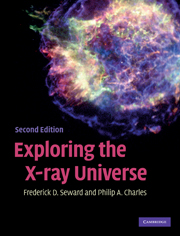Book contents
- Frontmatter
- Contents
- List of acronyms
- Foreword
- Chapter 1 Birth and childhood of X-ray astronomy
- Chapter 2 X-ray emission and interaction with matter
- Chapter 3 Tools and techniques
- Chapter 4 Solar system X-rays
- Chapter 5 X-ray absorption and scattering in the Interstellar Medium
- Chapter 6 Active stellar coronae
- Chapter 7 Early-type stars
- Chapter 8 Supernova explosions and their remnants
- Chapter 9 Neutron stars, pulsars, pulsar wind nebulae, and more supernova remnants
- Chapter 10 Cataclysmic variable stars
- Chapter 11 X-ray binaries
- Chapter 12 Black-hole X-ray binaries
- Chapter 13 Normal and starburst galaxies
- Chapter 14 Active galactic nuclei
- Chapter 15 Clusters of galaxies
- Chapter 16 The diffuse X-ray background
- Chapter 17 Gamma-ray bursts
- Index
- Plate section
Chapter 5 - X-ray absorption and scattering in the Interstellar Medium
Published online by Cambridge University Press: 05 June 2012
- Frontmatter
- Contents
- List of acronyms
- Foreword
- Chapter 1 Birth and childhood of X-ray astronomy
- Chapter 2 X-ray emission and interaction with matter
- Chapter 3 Tools and techniques
- Chapter 4 Solar system X-rays
- Chapter 5 X-ray absorption and scattering in the Interstellar Medium
- Chapter 6 Active stellar coronae
- Chapter 7 Early-type stars
- Chapter 8 Supernova explosions and their remnants
- Chapter 9 Neutron stars, pulsars, pulsar wind nebulae, and more supernova remnants
- Chapter 10 Cataclysmic variable stars
- Chapter 11 X-ray binaries
- Chapter 12 Black-hole X-ray binaries
- Chapter 13 Normal and starburst galaxies
- Chapter 14 Active galactic nuclei
- Chapter 15 Clusters of galaxies
- Chapter 16 The diffuse X-ray background
- Chapter 17 Gamma-ray bursts
- Index
- Plate section
Summary
The Interstellar Medium
The space between stars is not empty. It is full of gas and dust which are collectively called the Interstellar Medium or ISM. The ISM accounts for ~10 per cent of the mass of our Galaxy. To see anything beyond the Solar System, we must look through the ISM, and thus all observations are filtered and modified. In our Galaxy the gas forms a disc in the plane of the Milky Way, with diameter ≈30 kpc and thickness ≈0.7 kpc. The density averages about 1 atom/cm3, a far better vacuum than any that could be created here on Earth. This does not sound like much, but it is enough to absorb soft X-rays from most galactic sources. The composition of the gas is close to the usual cosmic abundance: 90 per cent H (by number), 10 per cent He and 0.1 per cent heavier elements. However, it is far from being a uniform medium. The neutral gas exists in a very large range of density, n, and temperature, T. A diffuse cloud might have n ~100 and T ~80 K. The medium between clouds might have n ~1 atoms cm−3 and T ~8000 K. There is also warm (8000 K) and hot (300 000 K) ionised material. Our interest here is in the neutral gas, which does most of the absorbing.
Neutral H in the ISM has, for more than 60 years, been directly observed in the radio band at a wavelength of 21.106 cm.
- Type
- Chapter
- Information
- Exploring the X-ray Universe , pp. 51 - 59Publisher: Cambridge University PressPrint publication year: 2010



